Discussion Paper: Financial Prudence and the IASB Conceptual Framework
VerifiedAdded on 2023/06/05
|12
|2949
|312
Report
AI Summary
This discussion paper, prepared for Big Phore Partners, delves into the concept of financial prudence and its implications for financial reporting, specifically in relation to the International Accounting Standards Board (IASB). The paper presents arguments both for and against the re-inclusion of prudence in the IASB's Conceptual Framework. Arguments against include potential conflicts with neutrality and faithful presentation, while arguments for highlight the protection of long-term investors and the role of cautious judgments in ensuring reliable financial information. The paper also includes a letter submitted to the IASB, supporting the update of the conceptual framework, and addressing the proposed re-introduction of prudence, emphasizing the need for a detailed definition of neutrality to avoid misinterpretations and ensure comparability of financial information. The report highlights the importance of prudence in maintaining the quality of financial reporting and protecting the interests of stakeholders.
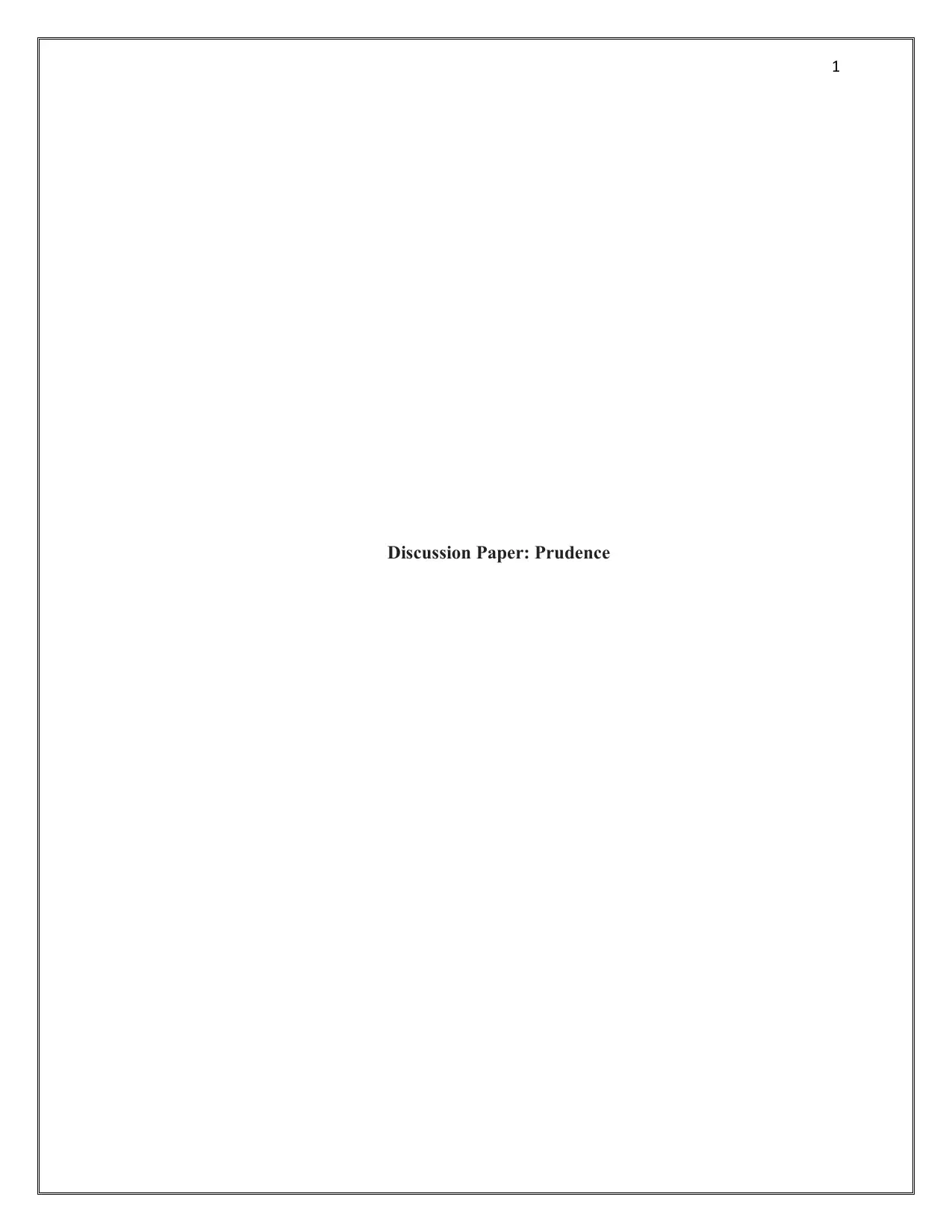
1
Discussion Paper: Prudence
Discussion Paper: Prudence
Paraphrase This Document
Need a fresh take? Get an instant paraphrase of this document with our AI Paraphraser

2
Contents
Introduction.................................................................................................................................................3
Part 1: Arguments for and Against the ‘Prudence’......................................................................................3
Arguments against the ‘Prudence’ Inclusion...........................................................................................3
Arguments for Inclusion of ‘Prudence’....................................................................................................5
Part 2: Exposure draft submitted to the IASB..............................................................................................7
Summary & Recommendations.................................................................................................................10
References.................................................................................................................................................11
Contents
Introduction.................................................................................................................................................3
Part 1: Arguments for and Against the ‘Prudence’......................................................................................3
Arguments against the ‘Prudence’ Inclusion...........................................................................................3
Arguments for Inclusion of ‘Prudence’....................................................................................................5
Part 2: Exposure draft submitted to the IASB..............................................................................................7
Summary & Recommendations.................................................................................................................10
References.................................................................................................................................................11
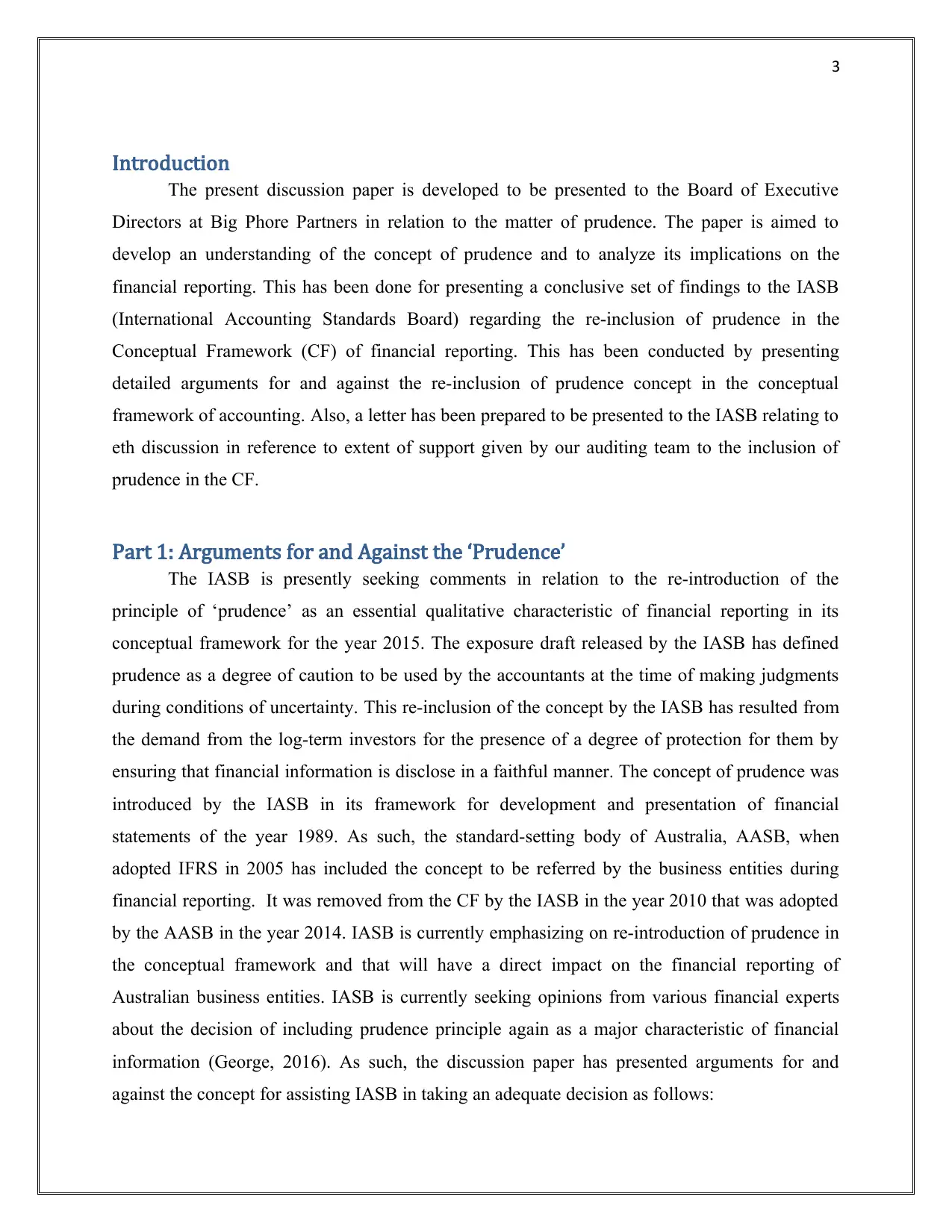
3
Introduction
The present discussion paper is developed to be presented to the Board of Executive
Directors at Big Phore Partners in relation to the matter of prudence. The paper is aimed to
develop an understanding of the concept of prudence and to analyze its implications on the
financial reporting. This has been done for presenting a conclusive set of findings to the IASB
(International Accounting Standards Board) regarding the re-inclusion of prudence in the
Conceptual Framework (CF) of financial reporting. This has been conducted by presenting
detailed arguments for and against the re-inclusion of prudence concept in the conceptual
framework of accounting. Also, a letter has been prepared to be presented to the IASB relating to
eth discussion in reference to extent of support given by our auditing team to the inclusion of
prudence in the CF.
Part 1: Arguments for and Against the ‘Prudence’
The IASB is presently seeking comments in relation to the re-introduction of the
principle of ‘prudence’ as an essential qualitative characteristic of financial reporting in its
conceptual framework for the year 2015. The exposure draft released by the IASB has defined
prudence as a degree of caution to be used by the accountants at the time of making judgments
during conditions of uncertainty. This re-inclusion of the concept by the IASB has resulted from
the demand from the log-term investors for the presence of a degree of protection for them by
ensuring that financial information is disclose in a faithful manner. The concept of prudence was
introduced by the IASB in its framework for development and presentation of financial
statements of the year 1989. As such, the standard-setting body of Australia, AASB, when
adopted IFRS in 2005 has included the concept to be referred by the business entities during
financial reporting. It was removed from the CF by the IASB in the year 2010 that was adopted
by the AASB in the year 2014. IASB is currently emphasizing on re-introduction of prudence in
the conceptual framework and that will have a direct impact on the financial reporting of
Australian business entities. IASB is currently seeking opinions from various financial experts
about the decision of including prudence principle again as a major characteristic of financial
information (George, 2016). As such, the discussion paper has presented arguments for and
against the concept for assisting IASB in taking an adequate decision as follows:
Introduction
The present discussion paper is developed to be presented to the Board of Executive
Directors at Big Phore Partners in relation to the matter of prudence. The paper is aimed to
develop an understanding of the concept of prudence and to analyze its implications on the
financial reporting. This has been done for presenting a conclusive set of findings to the IASB
(International Accounting Standards Board) regarding the re-inclusion of prudence in the
Conceptual Framework (CF) of financial reporting. This has been conducted by presenting
detailed arguments for and against the re-inclusion of prudence concept in the conceptual
framework of accounting. Also, a letter has been prepared to be presented to the IASB relating to
eth discussion in reference to extent of support given by our auditing team to the inclusion of
prudence in the CF.
Part 1: Arguments for and Against the ‘Prudence’
The IASB is presently seeking comments in relation to the re-introduction of the
principle of ‘prudence’ as an essential qualitative characteristic of financial reporting in its
conceptual framework for the year 2015. The exposure draft released by the IASB has defined
prudence as a degree of caution to be used by the accountants at the time of making judgments
during conditions of uncertainty. This re-inclusion of the concept by the IASB has resulted from
the demand from the log-term investors for the presence of a degree of protection for them by
ensuring that financial information is disclose in a faithful manner. The concept of prudence was
introduced by the IASB in its framework for development and presentation of financial
statements of the year 1989. As such, the standard-setting body of Australia, AASB, when
adopted IFRS in 2005 has included the concept to be referred by the business entities during
financial reporting. It was removed from the CF by the IASB in the year 2010 that was adopted
by the AASB in the year 2014. IASB is currently emphasizing on re-introduction of prudence in
the conceptual framework and that will have a direct impact on the financial reporting of
Australian business entities. IASB is currently seeking opinions from various financial experts
about the decision of including prudence principle again as a major characteristic of financial
information (George, 2016). As such, the discussion paper has presented arguments for and
against the concept for assisting IASB in taking an adequate decision as follows:
⊘ This is a preview!⊘
Do you want full access?
Subscribe today to unlock all pages.

Trusted by 1+ million students worldwide
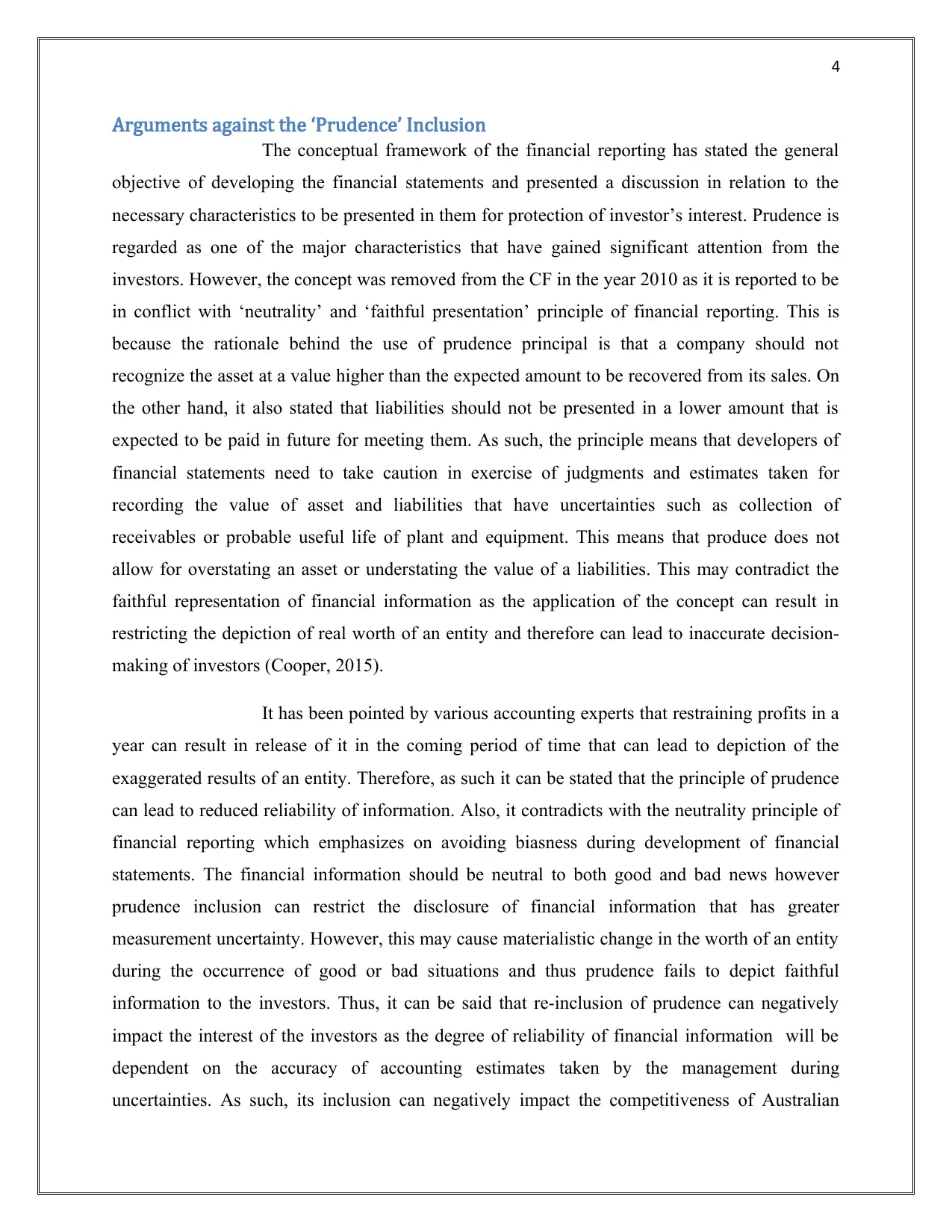
4
Arguments against the ‘Prudence’ Inclusion
The conceptual framework of the financial reporting has stated the general
objective of developing the financial statements and presented a discussion in relation to the
necessary characteristics to be presented in them for protection of investor’s interest. Prudence is
regarded as one of the major characteristics that have gained significant attention from the
investors. However, the concept was removed from the CF in the year 2010 as it is reported to be
in conflict with ‘neutrality’ and ‘faithful presentation’ principle of financial reporting. This is
because the rationale behind the use of prudence principal is that a company should not
recognize the asset at a value higher than the expected amount to be recovered from its sales. On
the other hand, it also stated that liabilities should not be presented in a lower amount that is
expected to be paid in future for meeting them. As such, the principle means that developers of
financial statements need to take caution in exercise of judgments and estimates taken for
recording the value of asset and liabilities that have uncertainties such as collection of
receivables or probable useful life of plant and equipment. This means that produce does not
allow for overstating an asset or understating the value of a liabilities. This may contradict the
faithful representation of financial information as the application of the concept can result in
restricting the depiction of real worth of an entity and therefore can lead to inaccurate decision-
making of investors (Cooper, 2015).
It has been pointed by various accounting experts that restraining profits in a
year can result in release of it in the coming period of time that can lead to depiction of the
exaggerated results of an entity. Therefore, as such it can be stated that the principle of prudence
can lead to reduced reliability of information. Also, it contradicts with the neutrality principle of
financial reporting which emphasizes on avoiding biasness during development of financial
statements. The financial information should be neutral to both good and bad news however
prudence inclusion can restrict the disclosure of financial information that has greater
measurement uncertainty. However, this may cause materialistic change in the worth of an entity
during the occurrence of good or bad situations and thus prudence fails to depict faithful
information to the investors. Thus, it can be said that re-inclusion of prudence can negatively
impact the interest of the investors as the degree of reliability of financial information will be
dependent on the accuracy of accounting estimates taken by the management during
uncertainties. As such, its inclusion can negatively impact the competitiveness of Australian
Arguments against the ‘Prudence’ Inclusion
The conceptual framework of the financial reporting has stated the general
objective of developing the financial statements and presented a discussion in relation to the
necessary characteristics to be presented in them for protection of investor’s interest. Prudence is
regarded as one of the major characteristics that have gained significant attention from the
investors. However, the concept was removed from the CF in the year 2010 as it is reported to be
in conflict with ‘neutrality’ and ‘faithful presentation’ principle of financial reporting. This is
because the rationale behind the use of prudence principal is that a company should not
recognize the asset at a value higher than the expected amount to be recovered from its sales. On
the other hand, it also stated that liabilities should not be presented in a lower amount that is
expected to be paid in future for meeting them. As such, the principle means that developers of
financial statements need to take caution in exercise of judgments and estimates taken for
recording the value of asset and liabilities that have uncertainties such as collection of
receivables or probable useful life of plant and equipment. This means that produce does not
allow for overstating an asset or understating the value of a liabilities. This may contradict the
faithful representation of financial information as the application of the concept can result in
restricting the depiction of real worth of an entity and therefore can lead to inaccurate decision-
making of investors (Cooper, 2015).
It has been pointed by various accounting experts that restraining profits in a
year can result in release of it in the coming period of time that can lead to depiction of the
exaggerated results of an entity. Therefore, as such it can be stated that the principle of prudence
can lead to reduced reliability of information. Also, it contradicts with the neutrality principle of
financial reporting which emphasizes on avoiding biasness during development of financial
statements. The financial information should be neutral to both good and bad news however
prudence inclusion can restrict the disclosure of financial information that has greater
measurement uncertainty. However, this may cause materialistic change in the worth of an entity
during the occurrence of good or bad situations and thus prudence fails to depict faithful
information to the investors. Thus, it can be said that re-inclusion of prudence can negatively
impact the interest of the investors as the degree of reliability of financial information will be
dependent on the accuracy of accounting estimates taken by the management during
uncertainties. As such, its inclusion can negatively impact the competitiveness of Australian
Paraphrase This Document
Need a fresh take? Get an instant paraphrase of this document with our AI Paraphraser
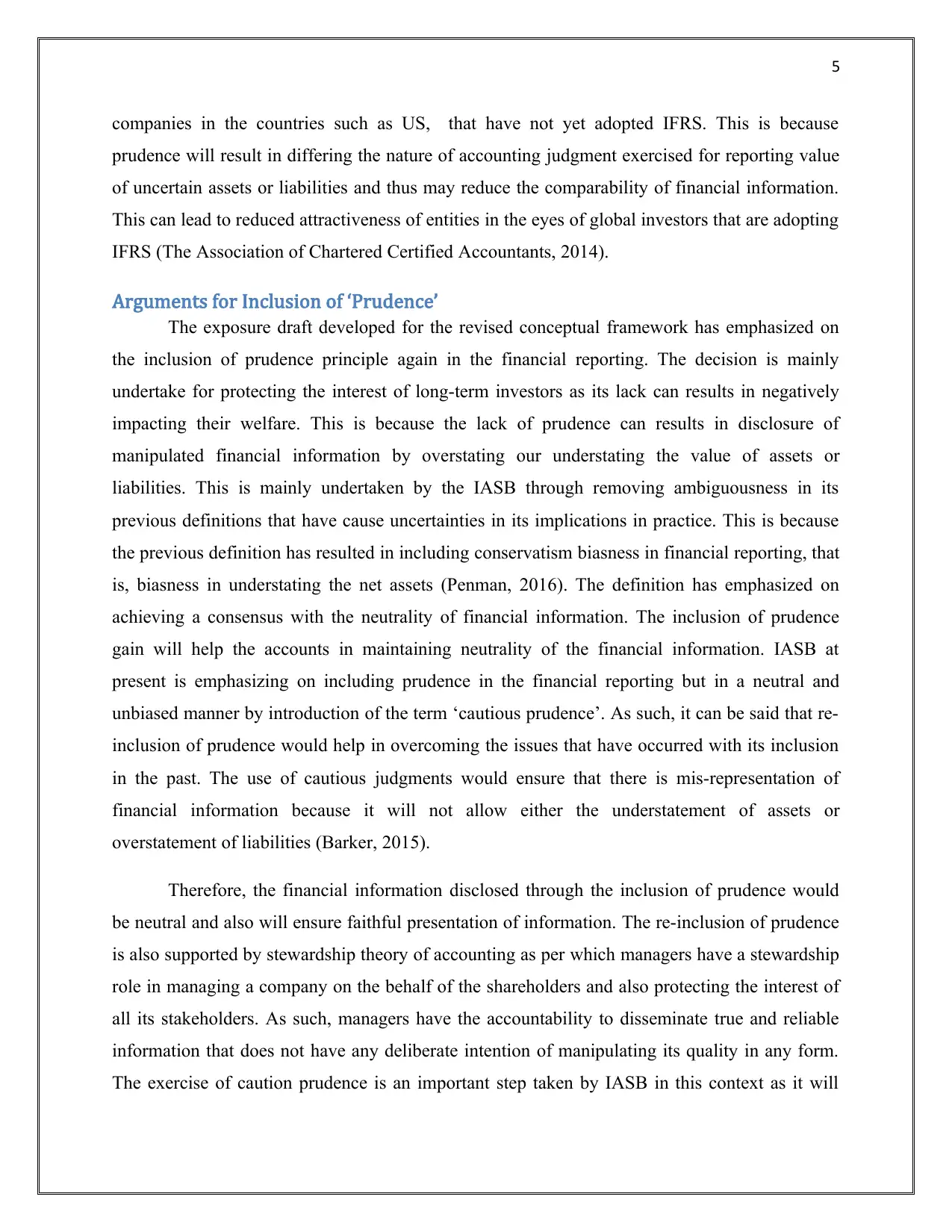
5
companies in the countries such as US, that have not yet adopted IFRS. This is because
prudence will result in differing the nature of accounting judgment exercised for reporting value
of uncertain assets or liabilities and thus may reduce the comparability of financial information.
This can lead to reduced attractiveness of entities in the eyes of global investors that are adopting
IFRS (The Association of Chartered Certified Accountants, 2014).
Arguments for Inclusion of ‘Prudence’
The exposure draft developed for the revised conceptual framework has emphasized on
the inclusion of prudence principle again in the financial reporting. The decision is mainly
undertake for protecting the interest of long-term investors as its lack can results in negatively
impacting their welfare. This is because the lack of prudence can results in disclosure of
manipulated financial information by overstating our understating the value of assets or
liabilities. This is mainly undertaken by the IASB through removing ambiguousness in its
previous definitions that have cause uncertainties in its implications in practice. This is because
the previous definition has resulted in including conservatism biasness in financial reporting, that
is, biasness in understating the net assets (Penman, 2016). The definition has emphasized on
achieving a consensus with the neutrality of financial information. The inclusion of prudence
gain will help the accounts in maintaining neutrality of the financial information. IASB at
present is emphasizing on including prudence in the financial reporting but in a neutral and
unbiased manner by introduction of the term ‘cautious prudence’. As such, it can be said that re-
inclusion of prudence would help in overcoming the issues that have occurred with its inclusion
in the past. The use of cautious judgments would ensure that there is mis-representation of
financial information because it will not allow either the understatement of assets or
overstatement of liabilities (Barker, 2015).
Therefore, the financial information disclosed through the inclusion of prudence would
be neutral and also will ensure faithful presentation of information. The re-inclusion of prudence
is also supported by stewardship theory of accounting as per which managers have a stewardship
role in managing a company on the behalf of the shareholders and also protecting the interest of
all its stakeholders. As such, managers have the accountability to disseminate true and reliable
information that does not have any deliberate intention of manipulating its quality in any form.
The exercise of caution prudence is an important step taken by IASB in this context as it will
companies in the countries such as US, that have not yet adopted IFRS. This is because
prudence will result in differing the nature of accounting judgment exercised for reporting value
of uncertain assets or liabilities and thus may reduce the comparability of financial information.
This can lead to reduced attractiveness of entities in the eyes of global investors that are adopting
IFRS (The Association of Chartered Certified Accountants, 2014).
Arguments for Inclusion of ‘Prudence’
The exposure draft developed for the revised conceptual framework has emphasized on
the inclusion of prudence principle again in the financial reporting. The decision is mainly
undertake for protecting the interest of long-term investors as its lack can results in negatively
impacting their welfare. This is because the lack of prudence can results in disclosure of
manipulated financial information by overstating our understating the value of assets or
liabilities. This is mainly undertaken by the IASB through removing ambiguousness in its
previous definitions that have cause uncertainties in its implications in practice. This is because
the previous definition has resulted in including conservatism biasness in financial reporting, that
is, biasness in understating the net assets (Penman, 2016). The definition has emphasized on
achieving a consensus with the neutrality of financial information. The inclusion of prudence
gain will help the accounts in maintaining neutrality of the financial information. IASB at
present is emphasizing on including prudence in the financial reporting but in a neutral and
unbiased manner by introduction of the term ‘cautious prudence’. As such, it can be said that re-
inclusion of prudence would help in overcoming the issues that have occurred with its inclusion
in the past. The use of cautious judgments would ensure that there is mis-representation of
financial information because it will not allow either the understatement of assets or
overstatement of liabilities (Barker, 2015).
Therefore, the financial information disclosed through the inclusion of prudence would
be neutral and also will ensure faithful presentation of information. The re-inclusion of prudence
is also supported by stewardship theory of accounting as per which managers have a stewardship
role in managing a company on the behalf of the shareholders and also protecting the interest of
all its stakeholders. As such, managers have the accountability to disseminate true and reliable
information that does not have any deliberate intention of manipulating its quality in any form.
The exercise of caution prudence is an important step taken by IASB in this context as it will
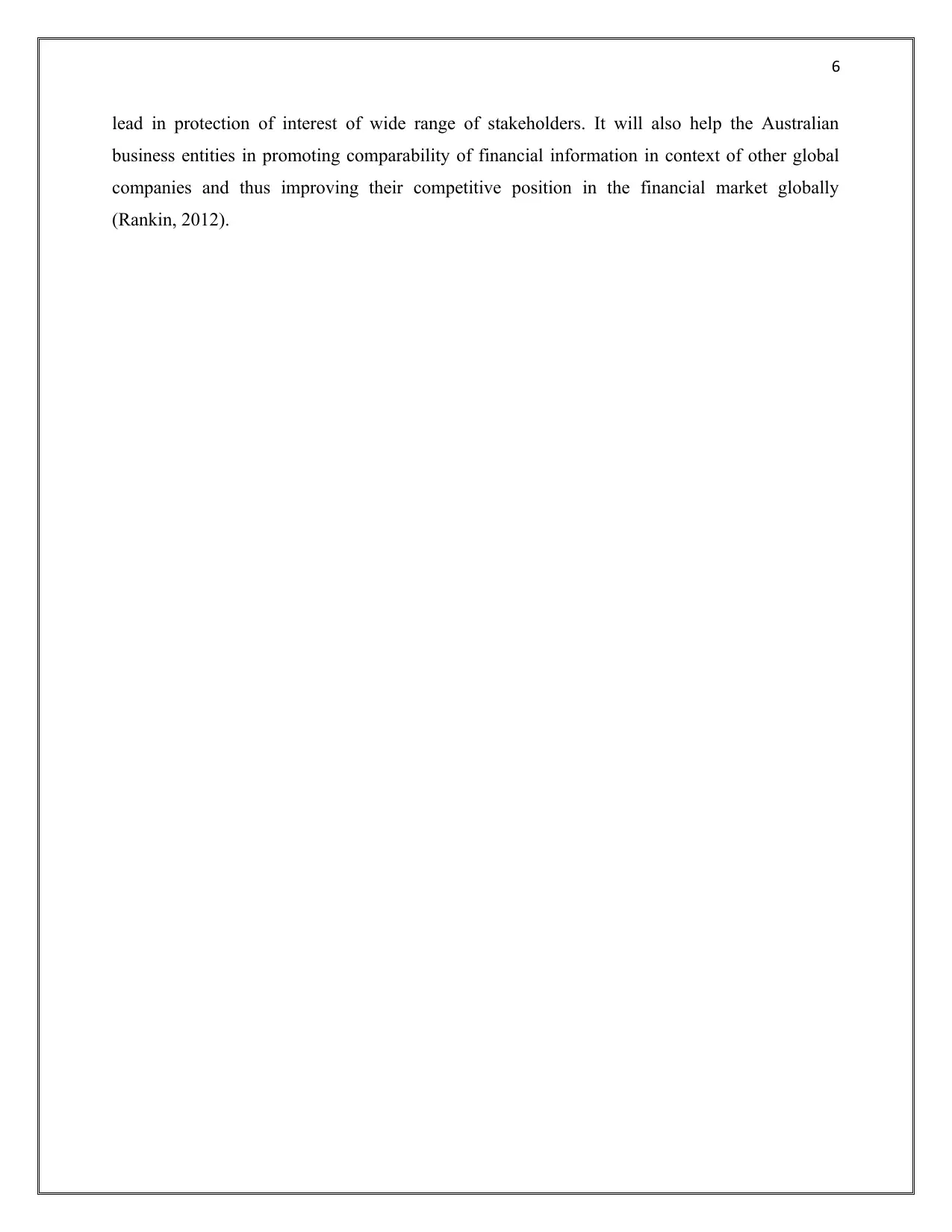
6
lead in protection of interest of wide range of stakeholders. It will also help the Australian
business entities in promoting comparability of financial information in context of other global
companies and thus improving their competitive position in the financial market globally
(Rankin, 2012).
lead in protection of interest of wide range of stakeholders. It will also help the Australian
business entities in promoting comparability of financial information in context of other global
companies and thus improving their competitive position in the financial market globally
(Rankin, 2012).
⊘ This is a preview!⊘
Do you want full access?
Subscribe today to unlock all pages.

Trusted by 1+ million students worldwide
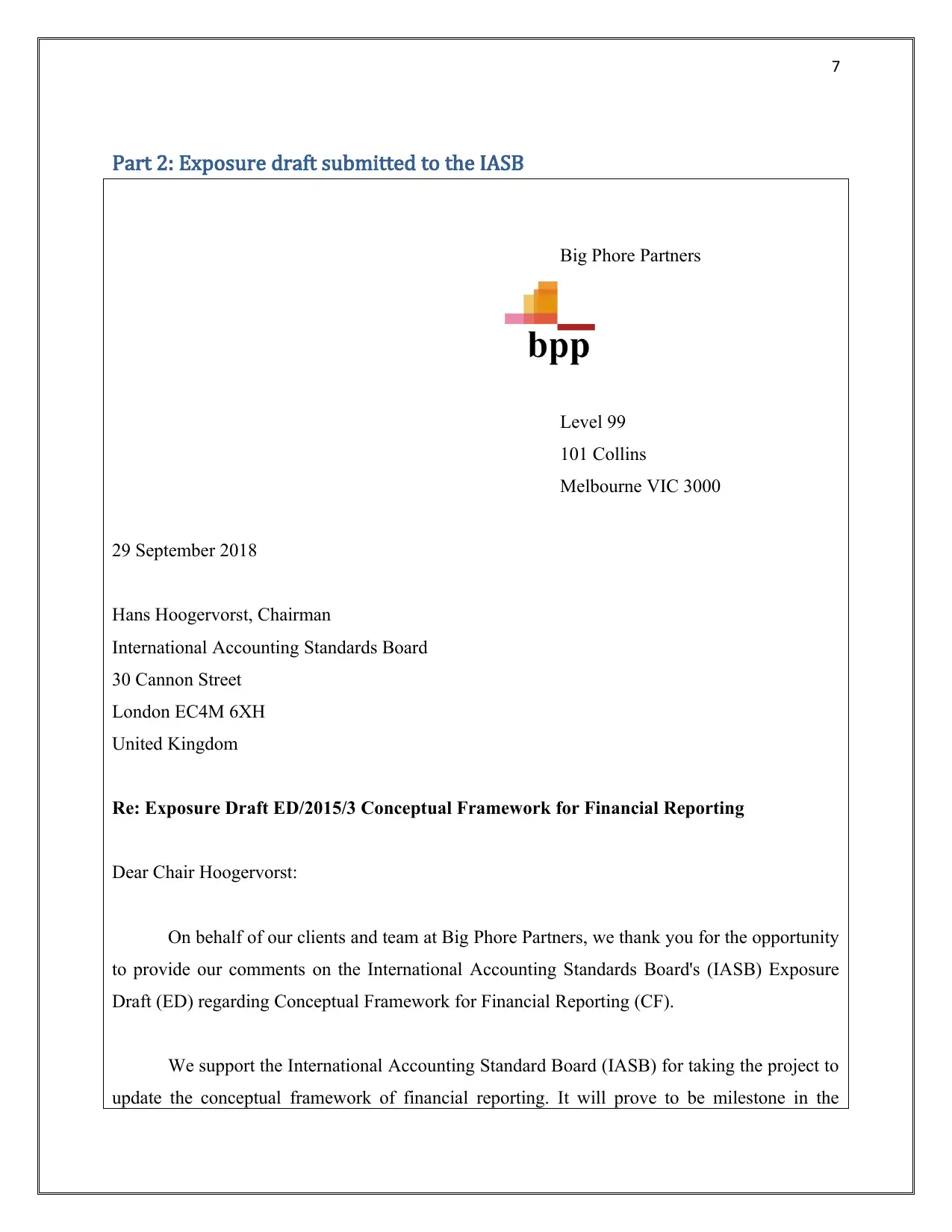
7
Part 2: Exposure draft submitted to the IASB
Big Phore Partners
Level 99
101 Collins
Melbourne VIC 3000
29 September 2018
Hans Hoogervorst, Chairman
International Accounting Standards Board
30 Cannon Street
London EC4M 6XH
United Kingdom
Re: Exposure Draft ED/2015/3 Conceptual Framework for Financial Reporting
Dear Chair Hoogervorst:
On behalf of our clients and team at Big Phore Partners, we thank you for the opportunity
to provide our comments on the International Accounting Standards Board's (IASB) Exposure
Draft (ED) regarding Conceptual Framework for Financial Reporting (CF).
We support the International Accounting Standard Board (IASB) for taking the project to
update the conceptual framework of financial reporting. It will prove to be milestone in the
Part 2: Exposure draft submitted to the IASB
Big Phore Partners
Level 99
101 Collins
Melbourne VIC 3000
29 September 2018
Hans Hoogervorst, Chairman
International Accounting Standards Board
30 Cannon Street
London EC4M 6XH
United Kingdom
Re: Exposure Draft ED/2015/3 Conceptual Framework for Financial Reporting
Dear Chair Hoogervorst:
On behalf of our clients and team at Big Phore Partners, we thank you for the opportunity
to provide our comments on the International Accounting Standards Board's (IASB) Exposure
Draft (ED) regarding Conceptual Framework for Financial Reporting (CF).
We support the International Accounting Standard Board (IASB) for taking the project to
update the conceptual framework of financial reporting. It will prove to be milestone in the
Paraphrase This Document
Need a fresh take? Get an instant paraphrase of this document with our AI Paraphraser
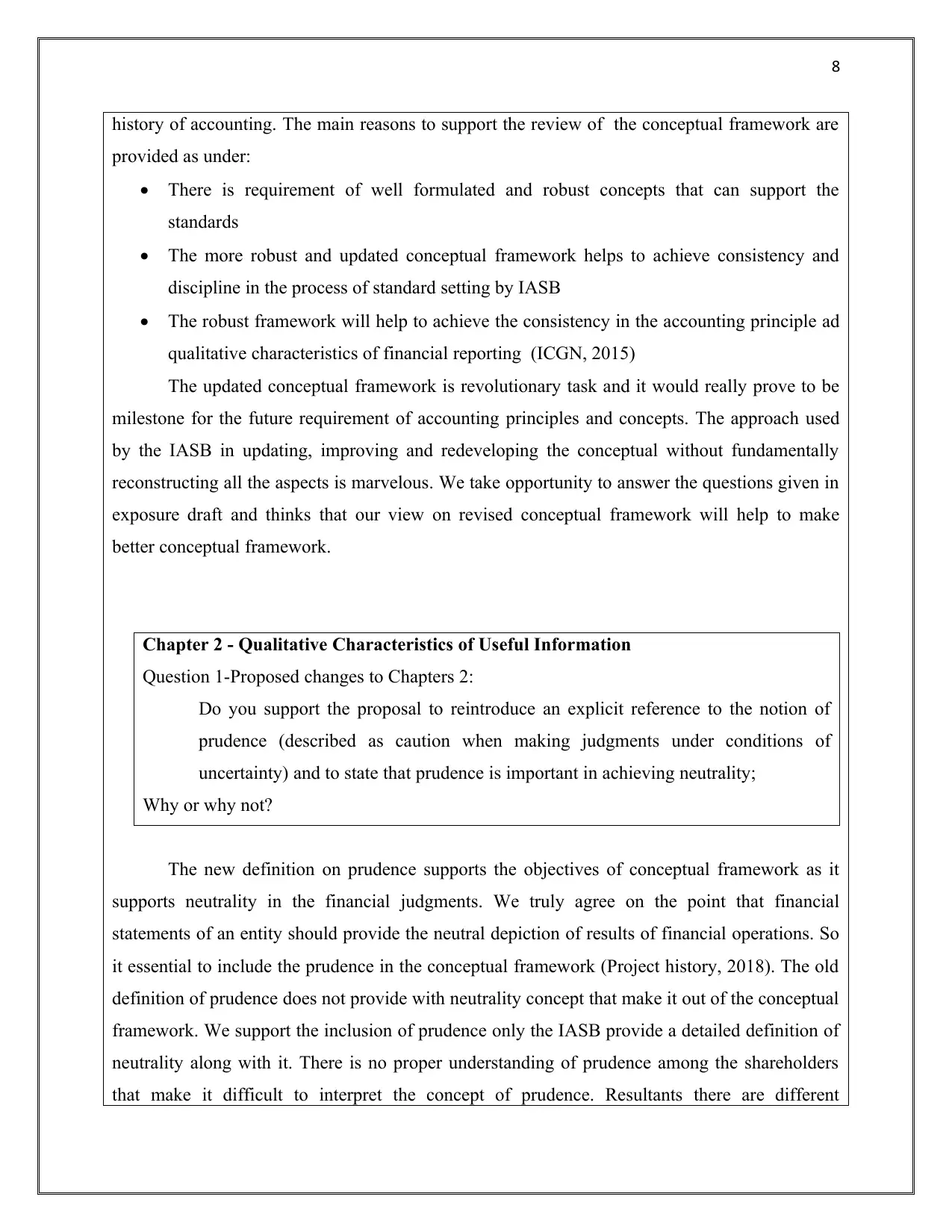
8
history of accounting. The main reasons to support the review of the conceptual framework are
provided as under:
There is requirement of well formulated and robust concepts that can support the
standards
The more robust and updated conceptual framework helps to achieve consistency and
discipline in the process of standard setting by IASB
The robust framework will help to achieve the consistency in the accounting principle ad
qualitative characteristics of financial reporting (ICGN, 2015)
The updated conceptual framework is revolutionary task and it would really prove to be
milestone for the future requirement of accounting principles and concepts. The approach used
by the IASB in updating, improving and redeveloping the conceptual without fundamentally
reconstructing all the aspects is marvelous. We take opportunity to answer the questions given in
exposure draft and thinks that our view on revised conceptual framework will help to make
better conceptual framework.
Chapter 2 - Qualitative Characteristics of Useful Information
Question 1-Proposed changes to Chapters 2:
Do you support the proposal to reintroduce an explicit reference to the notion of
prudence (described as caution when making judgments under conditions of
uncertainty) and to state that prudence is important in achieving neutrality;
Why or why not?
The new definition on prudence supports the objectives of conceptual framework as it
supports neutrality in the financial judgments. We truly agree on the point that financial
statements of an entity should provide the neutral depiction of results of financial operations. So
it essential to include the prudence in the conceptual framework (Project history, 2018). The old
definition of prudence does not provide with neutrality concept that make it out of the conceptual
framework. We support the inclusion of prudence only the IASB provide a detailed definition of
neutrality along with it. There is no proper understanding of prudence among the shareholders
that make it difficult to interpret the concept of prudence. Resultants there are different
history of accounting. The main reasons to support the review of the conceptual framework are
provided as under:
There is requirement of well formulated and robust concepts that can support the
standards
The more robust and updated conceptual framework helps to achieve consistency and
discipline in the process of standard setting by IASB
The robust framework will help to achieve the consistency in the accounting principle ad
qualitative characteristics of financial reporting (ICGN, 2015)
The updated conceptual framework is revolutionary task and it would really prove to be
milestone for the future requirement of accounting principles and concepts. The approach used
by the IASB in updating, improving and redeveloping the conceptual without fundamentally
reconstructing all the aspects is marvelous. We take opportunity to answer the questions given in
exposure draft and thinks that our view on revised conceptual framework will help to make
better conceptual framework.
Chapter 2 - Qualitative Characteristics of Useful Information
Question 1-Proposed changes to Chapters 2:
Do you support the proposal to reintroduce an explicit reference to the notion of
prudence (described as caution when making judgments under conditions of
uncertainty) and to state that prudence is important in achieving neutrality;
Why or why not?
The new definition on prudence supports the objectives of conceptual framework as it
supports neutrality in the financial judgments. We truly agree on the point that financial
statements of an entity should provide the neutral depiction of results of financial operations. So
it essential to include the prudence in the conceptual framework (Project history, 2018). The old
definition of prudence does not provide with neutrality concept that make it out of the conceptual
framework. We support the inclusion of prudence only the IASB provide a detailed definition of
neutrality along with it. There is no proper understanding of prudence among the shareholders
that make it difficult to interpret the concept of prudence. Resultants there are different
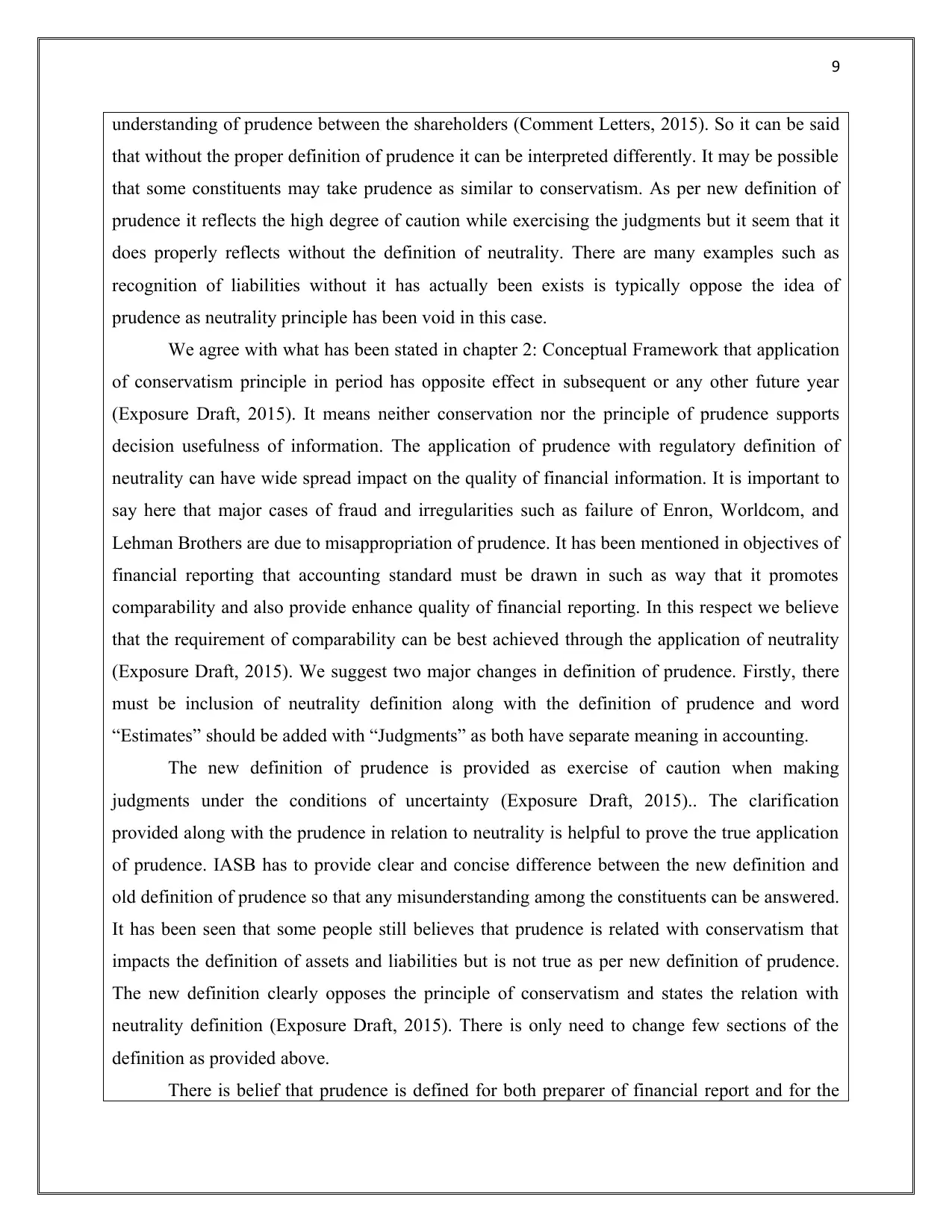
9
understanding of prudence between the shareholders (Comment Letters, 2015). So it can be said
that without the proper definition of prudence it can be interpreted differently. It may be possible
that some constituents may take prudence as similar to conservatism. As per new definition of
prudence it reflects the high degree of caution while exercising the judgments but it seem that it
does properly reflects without the definition of neutrality. There are many examples such as
recognition of liabilities without it has actually been exists is typically oppose the idea of
prudence as neutrality principle has been void in this case.
We agree with what has been stated in chapter 2: Conceptual Framework that application
of conservatism principle in period has opposite effect in subsequent or any other future year
(Exposure Draft, 2015). It means neither conservation nor the principle of prudence supports
decision usefulness of information. The application of prudence with regulatory definition of
neutrality can have wide spread impact on the quality of financial information. It is important to
say here that major cases of fraud and irregularities such as failure of Enron, Worldcom, and
Lehman Brothers are due to misappropriation of prudence. It has been mentioned in objectives of
financial reporting that accounting standard must be drawn in such as way that it promotes
comparability and also provide enhance quality of financial reporting. In this respect we believe
that the requirement of comparability can be best achieved through the application of neutrality
(Exposure Draft, 2015). We suggest two major changes in definition of prudence. Firstly, there
must be inclusion of neutrality definition along with the definition of prudence and word
“Estimates” should be added with “Judgments” as both have separate meaning in accounting.
The new definition of prudence is provided as exercise of caution when making
judgments under the conditions of uncertainty (Exposure Draft, 2015).. The clarification
provided along with the prudence in relation to neutrality is helpful to prove the true application
of prudence. IASB has to provide clear and concise difference between the new definition and
old definition of prudence so that any misunderstanding among the constituents can be answered.
It has been seen that some people still believes that prudence is related with conservatism that
impacts the definition of assets and liabilities but is not true as per new definition of prudence.
The new definition clearly opposes the principle of conservatism and states the relation with
neutrality definition (Exposure Draft, 2015). There is only need to change few sections of the
definition as provided above.
There is belief that prudence is defined for both preparer of financial report and for the
understanding of prudence between the shareholders (Comment Letters, 2015). So it can be said
that without the proper definition of prudence it can be interpreted differently. It may be possible
that some constituents may take prudence as similar to conservatism. As per new definition of
prudence it reflects the high degree of caution while exercising the judgments but it seem that it
does properly reflects without the definition of neutrality. There are many examples such as
recognition of liabilities without it has actually been exists is typically oppose the idea of
prudence as neutrality principle has been void in this case.
We agree with what has been stated in chapter 2: Conceptual Framework that application
of conservatism principle in period has opposite effect in subsequent or any other future year
(Exposure Draft, 2015). It means neither conservation nor the principle of prudence supports
decision usefulness of information. The application of prudence with regulatory definition of
neutrality can have wide spread impact on the quality of financial information. It is important to
say here that major cases of fraud and irregularities such as failure of Enron, Worldcom, and
Lehman Brothers are due to misappropriation of prudence. It has been mentioned in objectives of
financial reporting that accounting standard must be drawn in such as way that it promotes
comparability and also provide enhance quality of financial reporting. In this respect we believe
that the requirement of comparability can be best achieved through the application of neutrality
(Exposure Draft, 2015). We suggest two major changes in definition of prudence. Firstly, there
must be inclusion of neutrality definition along with the definition of prudence and word
“Estimates” should be added with “Judgments” as both have separate meaning in accounting.
The new definition of prudence is provided as exercise of caution when making
judgments under the conditions of uncertainty (Exposure Draft, 2015).. The clarification
provided along with the prudence in relation to neutrality is helpful to prove the true application
of prudence. IASB has to provide clear and concise difference between the new definition and
old definition of prudence so that any misunderstanding among the constituents can be answered.
It has been seen that some people still believes that prudence is related with conservatism that
impacts the definition of assets and liabilities but is not true as per new definition of prudence.
The new definition clearly opposes the principle of conservatism and states the relation with
neutrality definition (Exposure Draft, 2015). There is only need to change few sections of the
definition as provided above.
There is belief that prudence is defined for both preparer of financial report and for the
⊘ This is a preview!⊘
Do you want full access?
Subscribe today to unlock all pages.

Trusted by 1+ million students worldwide

10
standard setter. The new conceptual framework also provides with change in definition of assets
and liabilities to support their change in definition of prudence and inclusion of neutrality
concept (IFAC, 2015).
Thank you for the opportunity to provide our comments. If you have any questions,
please do not hesitate to contact me on +61(3) 9555 9999 or June.Coopers@bigphore.com.au
June Coopers, FCA, PhD, AO
Executive Chair
Summary & Recommendations
It can be stated from the overall analysis held out in the discussion paper that the topic of
prudence inclusion is still a topic of debate among the accounting professionals. The revised CF
introduced by IASB in the year 2015 has caused changes in the definition of prudence by
introduction of the term cautious prudence. This will help largely in overcoming the potential
difficulties that investors can face due to use of prudence in financial reporting process. The
letter submitted to the IASB has largely extended its support to its re-inclusion as it is now
believed to be consistent with neutrality principle and ensuring that it does not allow any
systematic biasness of financial information. It is therefore recommended to management of
business entities that application of prudence should be done to eliminate biasness by making
best use of accounting judgment and estimates during uncertain condition. This in necessary to
ensure so that its application does not reduce in the reliability of the financial information
presented.
standard setter. The new conceptual framework also provides with change in definition of assets
and liabilities to support their change in definition of prudence and inclusion of neutrality
concept (IFAC, 2015).
Thank you for the opportunity to provide our comments. If you have any questions,
please do not hesitate to contact me on +61(3) 9555 9999 or June.Coopers@bigphore.com.au
June Coopers, FCA, PhD, AO
Executive Chair
Summary & Recommendations
It can be stated from the overall analysis held out in the discussion paper that the topic of
prudence inclusion is still a topic of debate among the accounting professionals. The revised CF
introduced by IASB in the year 2015 has caused changes in the definition of prudence by
introduction of the term cautious prudence. This will help largely in overcoming the potential
difficulties that investors can face due to use of prudence in financial reporting process. The
letter submitted to the IASB has largely extended its support to its re-inclusion as it is now
believed to be consistent with neutrality principle and ensuring that it does not allow any
systematic biasness of financial information. It is therefore recommended to management of
business entities that application of prudence should be done to eliminate biasness by making
best use of accounting judgment and estimates during uncertain condition. This in necessary to
ensure so that its application does not reduce in the reliability of the financial information
presented.
Paraphrase This Document
Need a fresh take? Get an instant paraphrase of this document with our AI Paraphraser
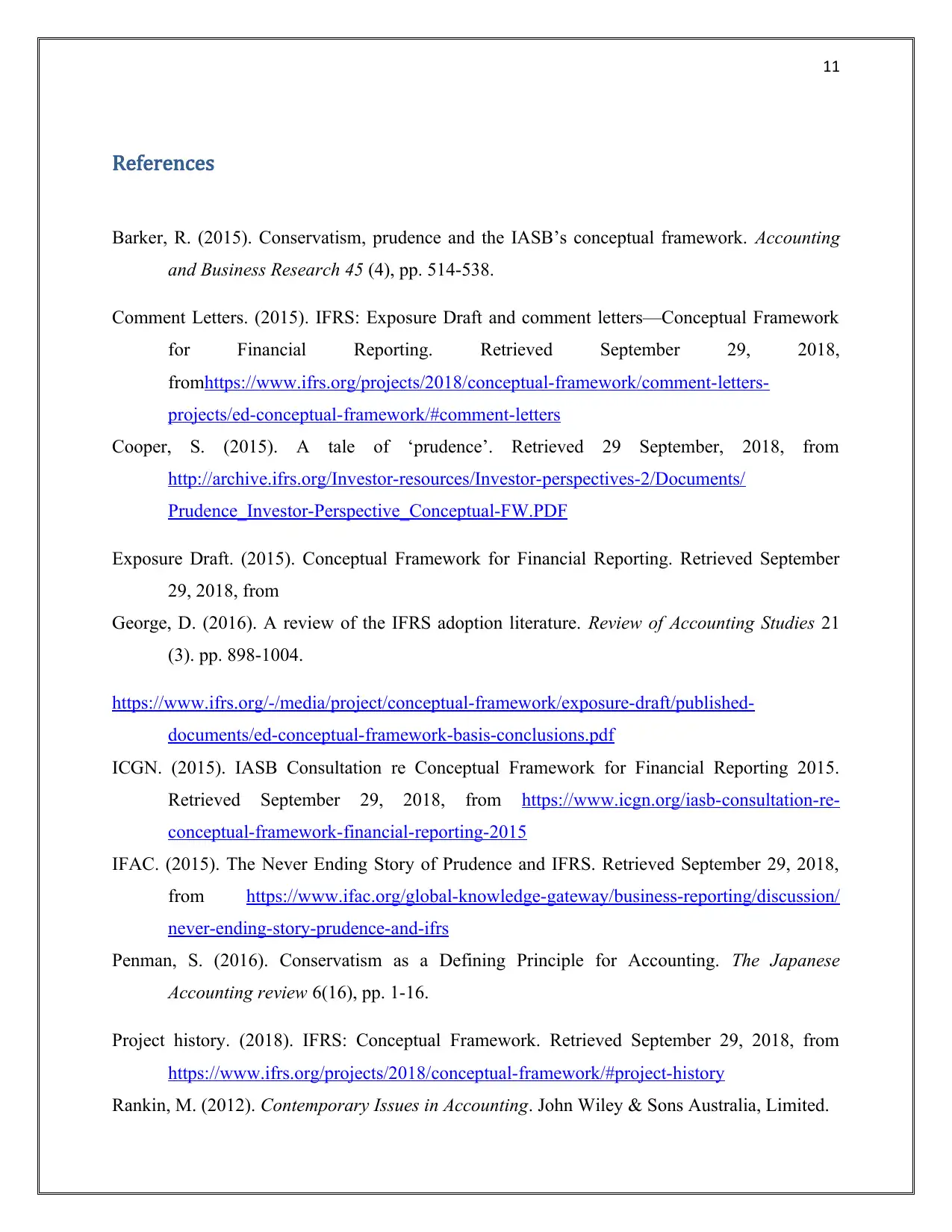
11
References
Barker, R. (2015). Conservatism, prudence and the IASB’s conceptual framework. Accounting
and Business Research 45 (4), pp. 514-538.
Comment Letters. (2015). IFRS: Exposure Draft and comment letters—Conceptual Framework
for Financial Reporting. Retrieved September 29, 2018,
fromhttps://www.ifrs.org/projects/2018/conceptual-framework/comment-letters-
projects/ed-conceptual-framework/#comment-letters
Cooper, S. (2015). A tale of ‘prudence’. Retrieved 29 September, 2018, from
http://archive.ifrs.org/Investor-resources/Investor-perspectives-2/Documents/
Prudence_Investor-Perspective_Conceptual-FW.PDF
Exposure Draft. (2015). Conceptual Framework for Financial Reporting. Retrieved September
29, 2018, from
George, D. (2016). A review of the IFRS adoption literature. Review of Accounting Studies 21
(3). pp. 898-1004.
https://www.ifrs.org/-/media/project/conceptual-framework/exposure-draft/published-
documents/ed-conceptual-framework-basis-conclusions.pdf
ICGN. (2015). IASB Consultation re Conceptual Framework for Financial Reporting 2015.
Retrieved September 29, 2018, from https://www.icgn.org/iasb-consultation-re-
conceptual-framework-financial-reporting-2015
IFAC. (2015). The Never Ending Story of Prudence and IFRS. Retrieved September 29, 2018,
from https://www.ifac.org/global-knowledge-gateway/business-reporting/discussion/
never-ending-story-prudence-and-ifrs
Penman, S. (2016). Conservatism as a Defining Principle for Accounting. The Japanese
Accounting review 6(16), pp. 1-16.
Project history. (2018). IFRS: Conceptual Framework. Retrieved September 29, 2018, from
https://www.ifrs.org/projects/2018/conceptual-framework/#project-history
Rankin, M. (2012). Contemporary Issues in Accounting. John Wiley & Sons Australia, Limited.
References
Barker, R. (2015). Conservatism, prudence and the IASB’s conceptual framework. Accounting
and Business Research 45 (4), pp. 514-538.
Comment Letters. (2015). IFRS: Exposure Draft and comment letters—Conceptual Framework
for Financial Reporting. Retrieved September 29, 2018,
fromhttps://www.ifrs.org/projects/2018/conceptual-framework/comment-letters-
projects/ed-conceptual-framework/#comment-letters
Cooper, S. (2015). A tale of ‘prudence’. Retrieved 29 September, 2018, from
http://archive.ifrs.org/Investor-resources/Investor-perspectives-2/Documents/
Prudence_Investor-Perspective_Conceptual-FW.PDF
Exposure Draft. (2015). Conceptual Framework for Financial Reporting. Retrieved September
29, 2018, from
George, D. (2016). A review of the IFRS adoption literature. Review of Accounting Studies 21
(3). pp. 898-1004.
https://www.ifrs.org/-/media/project/conceptual-framework/exposure-draft/published-
documents/ed-conceptual-framework-basis-conclusions.pdf
ICGN. (2015). IASB Consultation re Conceptual Framework for Financial Reporting 2015.
Retrieved September 29, 2018, from https://www.icgn.org/iasb-consultation-re-
conceptual-framework-financial-reporting-2015
IFAC. (2015). The Never Ending Story of Prudence and IFRS. Retrieved September 29, 2018,
from https://www.ifac.org/global-knowledge-gateway/business-reporting/discussion/
never-ending-story-prudence-and-ifrs
Penman, S. (2016). Conservatism as a Defining Principle for Accounting. The Japanese
Accounting review 6(16), pp. 1-16.
Project history. (2018). IFRS: Conceptual Framework. Retrieved September 29, 2018, from
https://www.ifrs.org/projects/2018/conceptual-framework/#project-history
Rankin, M. (2012). Contemporary Issues in Accounting. John Wiley & Sons Australia, Limited.
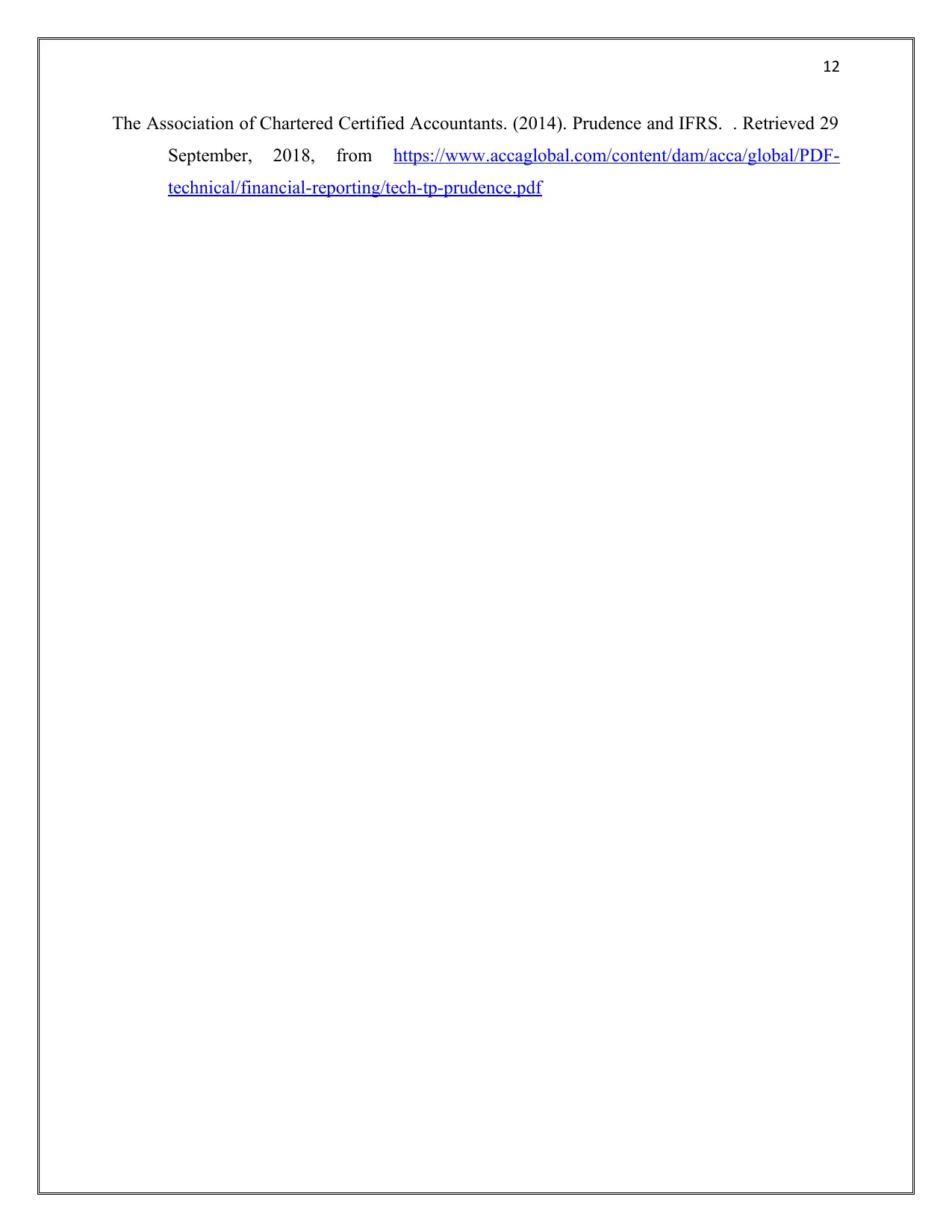
12
The Association of Chartered Certified Accountants. (2014). Prudence and IFRS. . Retrieved 29
September, 2018, from https://www.accaglobal.com/content/dam/acca/global/PDF-
technical/financial-reporting/tech-tp-prudence.pdf
The Association of Chartered Certified Accountants. (2014). Prudence and IFRS. . Retrieved 29
September, 2018, from https://www.accaglobal.com/content/dam/acca/global/PDF-
technical/financial-reporting/tech-tp-prudence.pdf
⊘ This is a preview!⊘
Do you want full access?
Subscribe today to unlock all pages.

Trusted by 1+ million students worldwide
1 out of 12
Related Documents
Your All-in-One AI-Powered Toolkit for Academic Success.
+13062052269
info@desklib.com
Available 24*7 on WhatsApp / Email
![[object Object]](/_next/static/media/star-bottom.7253800d.svg)
Unlock your academic potential
Copyright © 2020–2025 A2Z Services. All Rights Reserved. Developed and managed by ZUCOL.




